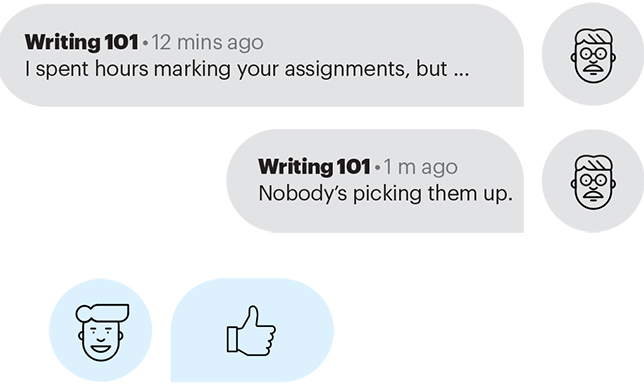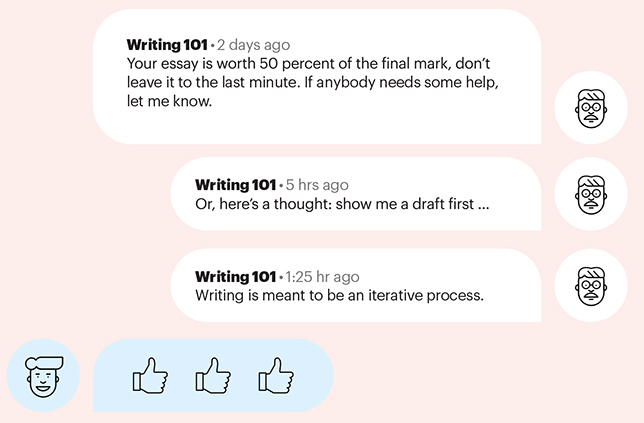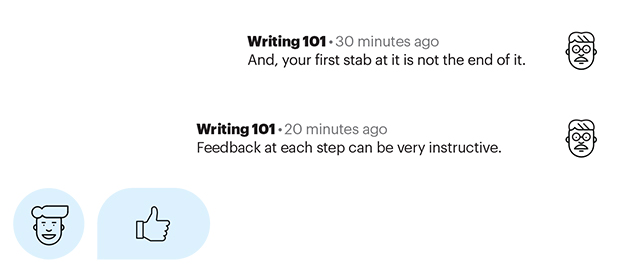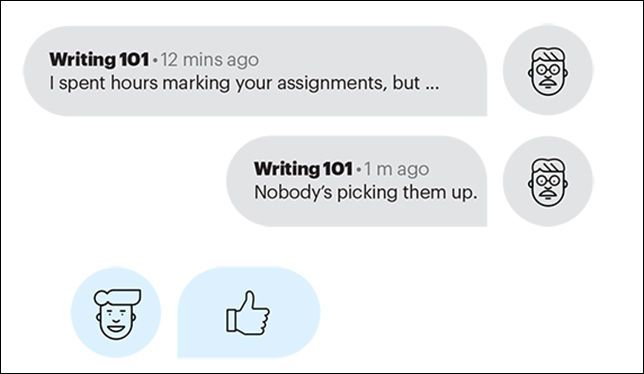To any teacher, including me, who teaches part time in a college writing program, the headline “New study shows significant amount of online feedback unopened by university students,” is at once alluring and maddening. Probably because it confirms what we’ve long suspected. But why? And more importantly, what can we do about it?
Such is the desperation of those who spend hours of our lives providing feedback and even more hours worrying about whether students really read it and will incorporate it not only into subsequent assignments, but into their learning more generally and even into their professional lives after graduation.
Only one thing to do, then: consult the study’s author, Paul Mensink, assistant professor in the department of biology and the Centre for Environment and Sustainability at Western University. And perhaps follow up with other professors working on the topic of feedback and assessment. Turns out they are a disparate bunch, working mostly in faculties of education and centres for teaching and learning, and with a range of specializations, from grade school up to postsecondary. Their advice provides lots of food for thought in terms of tweaking assignments, looking for inspiration from fellow teachers and creating learning communities out of classrooms.
Carried out at Queen’s University Belfast in collaboration with biology lecturer Karen King and published in 2019 in the British Journal of Educational Technology, Dr. Mensink’s study looked at nearly 1,500 assignments submitted through a learning management system by close to 500 students. The researchers found that when students could see their marks before opening their feedback, 42 percent of feedback files were not accessed by students. They also analyzed the results from various angles including gender and academic performance. One of the bigger revelations from drilling down into the data is that male students with low grade averages were even less likely to read feedback.
Dr. Mensink says the study’s results are demoralizing, suggesting that students don’t value the feedback and faculty feel like hours of their lives have gone to waste. “It’s bad on both ends,” he says. “It creates this negative cycle.” Yet a silver lining comes in the study’s other revelation: when marks were integrated into the assignment feedback, the amount of unopened feedback files dropped to 17 percent. Even the errant males with low grades were 27 times more likely to access their feedback when the mark was integrated with comments from the instructor.
It seems like a reasonable solution to the feedback problem – if only we could make that integration happen. Dr. Mensink is equally frustrated by the fact that most learning management systems are not designed to combine marks and feedback in this way and the developers he’s approached say that modifying the pre-programmed software is nearly impossible. He even tried going rogue on his own students at Western as an experiment: he entered all zeroes in the grades section of the platform and embedded their real marks within his written comments on the system. While he succeeded in making them hunt for their grades, the stunt also caused mass panic when the zeroes temporarily dropped their averages.

Challenges to overcome
Perhaps the larger question for teachers then is how to revamp assessment and feedback so that it becomes irresistible. Predictably, there are challenges. For university professors, teaching is central to the job but incidental in their training. “Professors are not specialized in assessment, so they ended up doing assessment the way that it was done to them,” says Christopher DeLuca, an associate professor in the faculty of education at Queen’s University and chair of the classroom assessment group in the American Educational Research Association. While centres for teaching and learning are now integral to many campuses, they are not always a required part of the graduate student curriculum.
In contrast with the K-12 classrooms that Dr. DeLuca also studies, where students have the opportunity for “rich feedback opportunities [from teachers] on a daily basis,” most professors also only see their students once a week. And then there’s the challenge of larger class sizes at universities, and the related challenge of professors passing assessment down to teaching assistants. Dr. DeLuca says it all adds up. “Intuitively professors do want to support student learning and assessment, but these are fairly large constraints.”
Jacqueline Leighton, a registered psychologist and a professor of educational psychology at the University of Alberta who specializes in measurement and evaluation, has spent 20 years in the field and is adamant about class size as a barrier. “Though there’s a great deal of lip service paid to feedback, the structural components of postsecondary education haven’t changed to allow proper feedback delivery,” says Dr. Leighton, who also feels strongly that the assessment field needs to spend more time focusing on the motivations of the learner.
Moving forward regardless
Despite these constraints, there has been progress over the years. Michelle Yeo, academic director for the Institute for the Scholarship of Teaching and Learning at Mount Royal University and president of the International Society for the Scholarship of Teaching and Learning, says the biggest shift has been the move from summative feedback given at the completion of an assignment to formative feedback, which focuses on ongoing feedback and revisions.
“There was a time when it was all about delivering the student a grade at the end and justifying that to the students,” says Dr. Yeo. “But most of us don’t tend to read feedback if the grade is already given. Students don’t even necessarily read the feedback on their final paper because the course is over and they’re moving onto the next thing,” she explains.
Jay Wilson, an associate professor and head of the department of curriculum studies in the college of education at the University of Saskatchewan, agrees that the move away from a single final essay or multiple-choice exam at the end of term is probably the biggest change he’s seen over his 20 years in the field. He advises teacher candidates in his courses to deliver “ongoing, feedback-driven, incremental learning that creates a feedback loop.” Today, some professors are getting students involved in that feedback loop as early as the development of the grading rubric for assignments. There are many advantages to doing so, including empowering students in their education by seeing assignments from a professor’s point of view. “We’re trying to get students to not be helpless [but rather] engaged in their learning so they understand who they are as learners,” says Dr. Wilson, adding that the process goes both ways, also helping professors realize what their students value as learners. Dr. Yeo agrees that having students think like assessors means that evaluation is no longer a mysterious formula in the professor’s head, and gives students confidence in their own assessment abilities. “It leads them to realize that they can recognize good work as well,” she says.

Creating a community of learners
Besides helping them to understand and contribute to assessment, co-creative rubric development also brings students closer to their professor and peers. Assessment experts say creating a community of learners within a course is yet another way to incorporate different and new forms of feedback into the classroom without adding burden on the professor. “Peer feedback means it’s not always on the professor to be providing feedback one by one, but more about the students learning to work as a community to provide feedback. It’s building relationships between the students,” says Dr. Yeo.
Dr. DeLuca adds that incorporating peer exercises can also help instructors overcome some of the other challenges of larger classes. “Big classes where students don’t know anybody can be socially isolating experiences. When you form a learning community, then students don’t feel like they’re in it alone.” Discussion boards within learning management tools are increasingly being used to extend and replicate classroom discussions online, providing another space to further develop that community.
Focusing on developing good emotional relationships with students is also fundamental to creating that healthy community, says Dr. Leighton, since the learner needs to trust the person who is assessing them. Offering to meet with students, engaging in regular dialogue, and even admitting when you don’t have an answer to a question are all ways that professors can make them seem more approachable. “If professors set themselves up as infallible, that becomes very intimidating for students, so they won’t seek out the professor,” says Dr. Leighton.
Feedback inspiration
Providing continuous feedback means considering types of assignments that involve several short deadlines or revisions. Dr. Wilson says the education department at U of S has long abandoned final exams, and instead centres final assessments around learning portfolios, a collection of documents and artifacts a teacher candidate collects throughout the program that show competence in the discipline, such as lesson plans, rubrics and syllabi. He then engages candidates in a conversation to analyze his feedback on their performance and discuss the progression of their learning.
Where he does have self-contained assignments, Dr. Wilson says they are always open to revision. “I have deadlines but I never have final deadlines. I allow students to continually submit. And I know that … everyone who reads that will say, ‘Wilson, you’re a fool because you’re always marking.’ But not everybody takes me up on it. And students who really need that will take advantage of it. It helps them learn.”
Perhaps one root of inertia when it comes to changing up assignments can be the fact that disciplines tend to stick to particular formats, although not without good reason. “Those practices aren’t idiosyncratic. They tell us something about what the discipline values,” says Dr. Yeo, noting for instance that science tends to aim for quantitative measurements of student learning, whereas the humanities focus on written work. Yet using only those pet forms can make the learning rote, says Dr. Yeo, giving the example of a business school that only does case studies and presentations. “If students just keep doing the same thing over and over again, they’re not necessarily expanding or thinking reflectively about what they’re getting out of it.”
But instructors can also search their own departments for inspiration. Dr. Yeo points to a colleague in her program who now schedules 15-minute meetings with each student to discuss their final projects and marks. Dr. Wilson adds that working in an interdisciplinary field as he does means that inspiration can also cross over from other departments. He was recently impressed by a colleague in soil science who asks students to walk him through a plot of land, identifying soil composition, flora and fauna as they go.
Dr. Yeo also reminds professors that they don’t need to change everything all at once. “People often feel that within a department it’s risky to do anything too crazy, but you could take one assignment in your course and do something really interesting and different with it, and see how it goes,” she says.

New ideas and experiments
For Dr. Mensink at Western, studying feedback failure has inspired him to try new approaches in his own classroom. He’s shifted all of his major assignment deadlines to mid-semester so that students can do more with his feedback before the course ends. He’s also made the major assignment in his first-year environmental science and sustainability course more formative, asking students to resubmit their major assignment. The assignment is a “perspectives article,” where they review the importance of a scientific paper to the field. The first round of feedback provides queries in the style of a peer reviewer, and the second step then involves students responding to that feedback. Like many teachers, Dr. Mensink is finding it’s a work in progress – the first time he tried it, his second-draft requirements didn’t integrate enough of the first-draft feedback. He’s also given his TAs (the course has 200 students) more specific instructions to spend more of their marking time on the first draft. “It’s shifting time and resources to where feedback’s going to be used the most,” he says.
Another tip for rebooting feedback is to remember it doesn’t all have to be formal. “Feedback is more than just the comments you get back on a test. Feedback can also be very fluid and dynamic within the class,” says U of A’s Dr. Leighton, adding that she uses Jeopardy!-style games and critical discussions of current events as tools. “Even in a class of 80, if you can set up an environment of comfort and safety where everybody feels at ease sharing their opinions and asking questions, that creates a dialogue.”
Technology is also helping assessment become more interactive, with many tools now on the market. Dr. Wilson uses a platform called Nearpod to engage students in brainstorming and peer-writing exercises. Other companies, like Canada-based Top Hat, offer tools such as interactive polling and discussions that allow students to use their own devices and link to learning management systems. Dr. DeLuca at Queen’s says new tools at the K-12 level facilitate peer feedback and group assessment. And, innovations to standardized testing, like adaptive tests that fine-tune the measurement of a student’s competency by adjusting test difficulty on the fly, will soon make their way to universities. Virtual reality and simulations technologies are already starting to make their way into assessment in some fields such as medicine and dentistry.
Learning to learn
Beyond drilling content, these assessment scholars also say that feedback should help students develop their learning skills. Dr. DeLuca says that studies in the K-12 context show that when teachers tailor feedback to improve learning and not just the outcome of a particular assignment, achievement increases, so it’s helpful to be specific about how students can do better next time. “Give them content feedback, but also give them ways that they might learn how to learn. For example, you might say, ‘to get this concept you should re-read chapters two and three and make up some practice questions for yourself.’” Dr. DeLuca says this has the added benefit of having students focus less on the grade and more on the learning process. “They get into more deeper learning as opposed to surface learning.” Mount Royal’s Dr. Yeo agrees. “It helps students to take ownership of their own learning and think about ‘what do I need to learn next?’ It’s moving it from extrinsic motivation to intrinsic motivation.”
Teaching students to self-assess and incorporate feedback to achieve a higher outcome ultimately means the difference between informing and teaching, says Dr. Wilson, adding that he often reinforces this to his teacher candidates. “The student needs you to give them formative feedback. If not, then why not just give them a list of topics and they can watch videos online? If you’re not assessing, you’re just Google.”

We need to stop begging and dragging students kicking and screaming into caring about their learning and academic progress. If they don’t care, one might ask why they’re there but that’s their choice. A very expensive, labour intensive, time consuming choice. They’re grown adults.
If they want to learn and benefit from feedback, they know how to access it. If they don’t want to engage, that’s their choice. If they don’t want to maximise their benefit, that’s on them. They’ll experience the consequences of failing to do so.
As was explained to me by several students, if they’re not planning to pursue subsequent studies, their grades don’t matter. Employers don’t look at grades. The majority of students are only in university to “get a good job” but don’t even know what that job might be. Let them figure it out.
Yes, it might be frustrating to watch but those who are frustrated are the same people who pursued feedback when they were students. That’s what got us into grad school and subsequently, into faculty positions. It bothers us because we care about academics and higher learning. That doesn’t mean that every student is going to nor should value what we value. This is their academic journey, not our academic journey.
We value the feedback. That doesn’t mean they have to value the feedback. We provide the feedback because we want to see them do better, make gains and capitalise on it. That doesn’t mean they have to want to do better, make gains and capitalise on it.